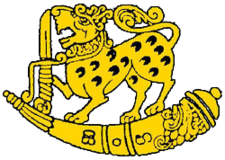1755
The 60th was raised locally in North America in response to the defeat of General Braddock by the French and the Indians in the summer of 1755. Scarlet Jackets, rigid linear formations, overburdened soldiers, ponderous movement and conventional European tactics had contributed to the disaster. Though at this time they were neither a Light Infantry nor a Rifle Regiment, the 60th had a profound influence on the later developments of these units. Primarily under Lieutenant Colonel Bouquet, a Swiss, the Commanding Officer of the 1st Battalion, new ideas were developed. He dressed the men in buckskin and homespun dyed dark green or brown, with black horn buttons made locally. Light equipment, simple drills and open formations were used. He looked to the welfare of his men and discipline was firm but not harsh. Mobility, marksmanship, individual initiative, constant alertness and concealment were stressed, and proven successful in subsequent engagements.
1797
The first battalion to be armed with the rifle, to wear the green jacket, to carry no colours, to use the bugle-horn to direct movements and to abandon the rigid style of marching was the famous 5th Battalion 60th. Its first Commanding Officer, de Rottenburg, prepared 'Regulations for the Exercises of Riflemen and Light Infantry' which Sir John Moore later accepted as the basis for the training of the Light Brigade.
1800
Colonel Coote Manningham raised the Experimental Corps of Riflemen from the pick of fifteen regiments. They were armed throughout with the Baker Rifle and were an elite of what was, in a few years, to prove to be the best infantry in Europe, the British. In 1803, Coote Manningham, 'the father of thinking Rifleman' gave his first military lectures on the duties of riflemen, drawing on de Rottenburg's Regulations'. Not only did these lectures serve as the basis for the operations of the Light Brigade (later Division) in the Peninsular War but they were remarkable for containing much that remains up-to-date.
Modern infantry tactics, combining dispersion and movement supported by accurate economical fire, personal camouflage and concealment, the effective use of ground mobility and above all the use of individual intelligence and initiative were all anticipated some 200 years ago. His instructions consistently emphasized humanity rare for a time when oaths, blows and floggings were a custom. He also looked after the well being of his Riflemen's families at a time when the authorities did nothing in this regard.
1803
General Sir John Moore, considered to be perhaps the finest trainer of British infantry, formed and trained the Light Brigade, consisting of the 43rd the 52nd and the 95th. His ideal was the thinking fighting man, in essence the infantryman of the future. A former Major with the 60th, Moore drew on this experience, the work of de Rottenburg and Coote Manningham and his own study of foreign light corps in developing and training the Light Brigade.
He regarded soldiers as human beings who could be trained to use their individual initiative, to be self-reliant and to improve themselves, given the opportunity. Harsh and brutal punishment was abandoned. Discipline was firm and aimed at preventing rather than discouraging crime. Whenever possible orders were clear and explained to their recipients as opposed to a demand for blind obedience. Realistic training for war rather than ceremony was the practice.
Constant alertness and readiness for action were emphasized. Marksmanship was stressed and practiced with all movements covered by effective fire. Field drills were practiced first close order on the parade ground and then in extended order directed by bugle-horn and whistle. The men were trained to march freely and easily to obtain maximum speed with minimum fatigue.
The Light Brigade was trained to carry out tactical rescue and to cover both the advance and retreat of any army (both heretofore traditional horse cavalry roles), responsibilities it carried out with outstanding success and enduring fame during the Peninsular War of 1808 - 1814, led by the colourful and famous 'Black Bob' Crawford, a former Lieutenant Colonel of the 5th Battalion 60th.
The 5th Battalion 60th had one or more of its ten companies attached to each of Wellington’s seven regular (or heavy) infantry Brigades. A remarkable tribute to the effectiveness of these companies was given in a dispatch of the French Marshal Soult. To explain his disproportionately high loss of officers he said it was caused by these companies. The men were armed with a short rifle, selected for their marksmanship, "they acted as scouts and picked off officers, whenever a superior officer goes to the front, he is usually hit".
Wellington also ordered that these companies be formed on the left of the Brigade, perhaps the origin of a Rifle Regiment's place on the left when on parade with other units. This was, of course, not the companies' position in battle.





